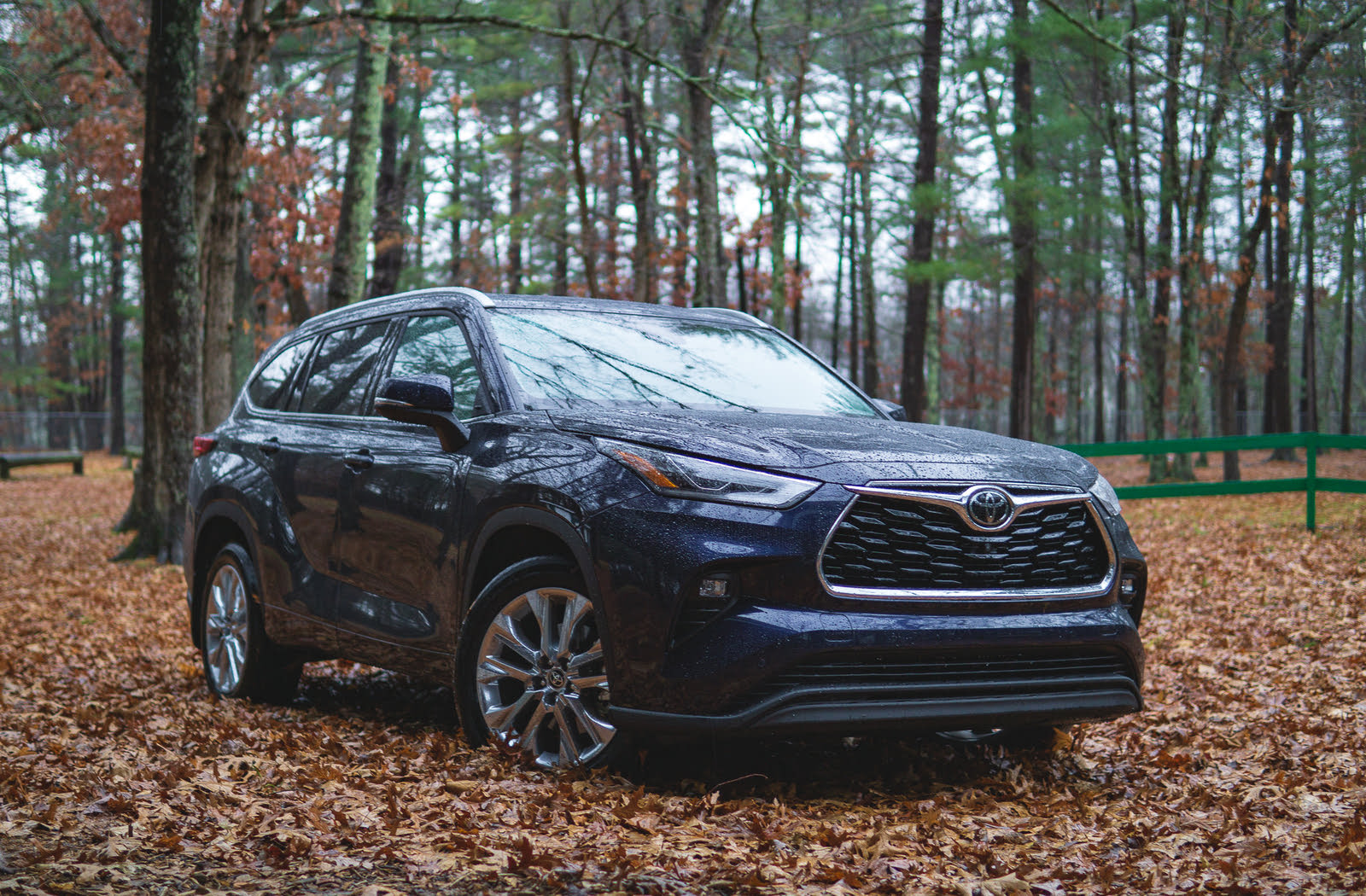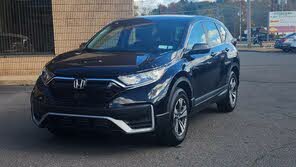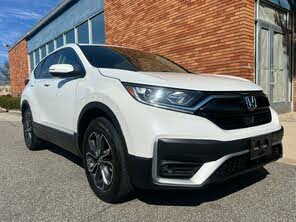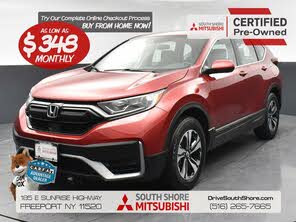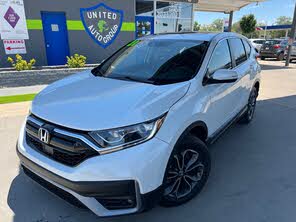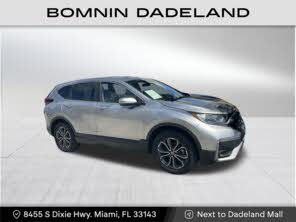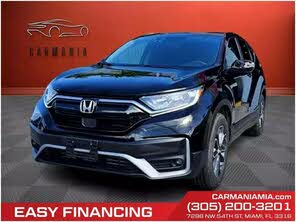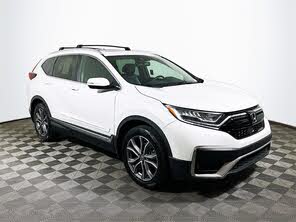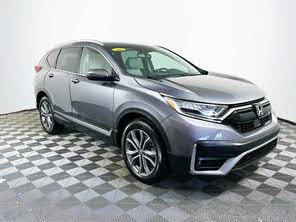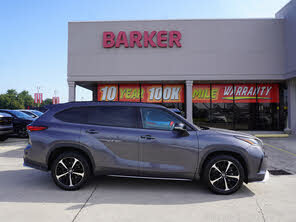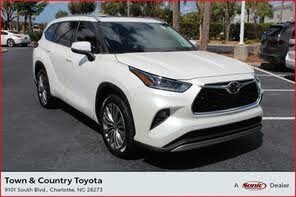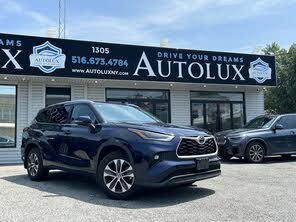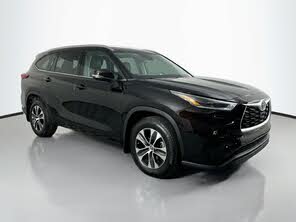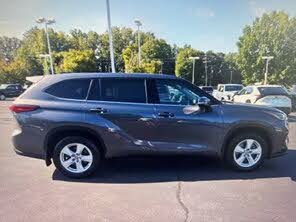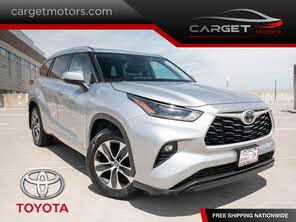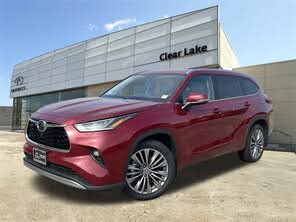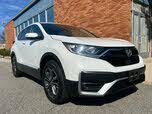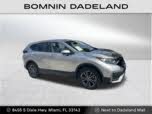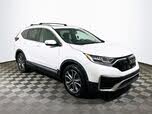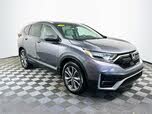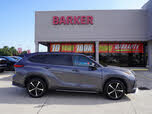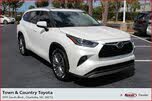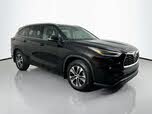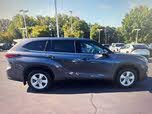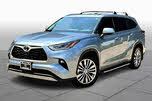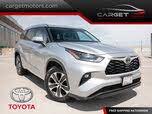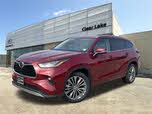2021 Honda CR-V vs 2021 Toyota Highlander
CarGurus highlights

According to CarGurus experts, the overall rating for the 2021 Toyota Highlander was 7.5 out of 10, while the 2021 Honda CR-V scored 7.8 out of 10. Given these ratings, the Honda CR-V emerged as the slightly better choice. Its efficient use of interior space, excellent safety features available across all trims, and a practical design made it a favorite for families and everyday use. Although the Highlander offered more seating and upscale finishes, the CR-V’s all-around excellence made it the preferred vehicle.
Choose the 2021 Honda CR-V if:
- Safety features are critical, and you appreciate getting most of them standard.
- Practicality in interior space and cargo volume for five passengers suits your needs.
- You prefer a more varied infotainment setup with available advanced navigation and audio systems.
Choose the 2021 Toyota Highlander if:
- You desire a larger SUV with additional seating and cargo capacity.
- Premium interior styling and upscale finishes are important to you.
- Safety and a wide array of advanced driver assistance features are top priorities.
Overview | |
MSRP$35,085 | MSRP$25,350 |
Average price$33,490 | Average price$26,136 |
Listings2184 | Listings1949 |
Ratings & Reviews | |
User Reviews | User Reviews |
Expert reviews7.5 out of 10 | Expert reviews7.8 out of 10 |
Pros
| Pros
|
2021 Toyota Highlander Reviews SummaryToyota hardly needs any help selling three-row Highlanders. It already sits close to the top of the sales charts for its segment, and few vehicles carry the name recognition as the Highlander, which enters into its 20th year of production. But the three-row marketplace is a competitive one, and even after a 2020 redesign, Toyota would be foolish to rest on its laurels. As such, the Highlander enters this year with additional safety-feature technology listed as standard equipment. | |
2021 Honda CR-V Reviews SummaryEven in a grim year, Honda is selling a staggering number of CR-Vs. The CR-V is the best-selling Honda by far. It’s also the second best-selling compact SUV, just behind the Toyota RAV4. And it's the fifth best-selling vehicle in the U.S., and if you take out all the commercial sales of full-size pickups it’s one of the two best-selling vehicles year in and year out. So it’s hard to argue against the CR-V formula. Honda’s been at this almost as long as crossovers have been a thing, launching the CR-V in 1997—a year after the RAV4 debuted. The funny thing is, aside from sales volume, there’s only one thing the CR-V particularly excels at. Aesthetics are subjective, but it would be hard to argue the CR-V is the best looking vehicle in its class. It’s not the cheapest. It’s not the best equipped, especially at the middle to lower trim levels. It’s not the fastest, nor is it the quietest, or the most fuel efficient. It’s not even the most reliable, showing up nowhere in J.D. Power's Most Reliable list. So what makes it so appealing to American consumers? Let’s see if we can figure that out. | |
No video found | |
Popular Features & Specs | |
Engine3.5L 295 hp V6 | Engine1.5L 190 hp I4 |
Drive TrainFWD | Drive TrainFWD |
Seating Capacity8 | Seating Capacity5 |
Horsepower295 hp @ 6600 rpm | Horsepower190 hp @ 5600 rpm |
MPG City20 | MPG City28 |
MPG Highway28 | MPG Highway34 |
Engine | |
Engine Name3.5L 295 hp V6 | Engine Name1.5L 190 hp I4 |
Torque263 lb-ft @ 4700 rpm | Torque179 lb-ft @ 2000 rpm |
Horsepower295 hp @ 6600 rpm | Horsepower190 hp @ 5600 rpm |
DrivetrainFWD | DrivetrainFWD |
Fuel Economy | |
MPG City20 | MPG City28 |
MPG Highway28 | MPG Highway34 |
Interior | |
Seating Capacity8 | Seating Capacity5 |
Safety | |
Front Crash Overall4 | Front Crash Overall5 |
Side Crash Overall5 | Side Crash Overall5 |
Dimensions & Capacity | |
Cargo Space16.0 cu ft | Cargo Space39.2 cu ft |
Curb Weight4145 lbs | Curb Weight3337 lbs |
Height68.1 in | Height66.1 in |
Length194.9 in | Length182.1 in |
Width76.0 in | Width73.0 in |
Wheelbase112.2 in | Wheelbase104.8 in |
Maximum Payload1685 lbs | Maximum Payload1358 lbs |
Number of doors4 | Number of doors4 |
Maximum Towing Capacity5000 lbs | Maximum Towing Capacity1500 lbs |
CarGurus highlights

According to CarGurus experts, the overall rating for the 2021 Toyota Highlander was 7.5 out of 10, while the 2021 Honda CR-V scored 7.8 out of 10. Given these ratings, the Honda CR-V emerged as the slightly better choice. Its efficient use of interior space, excellent safety features available across all trims, and a practical design made it a favorite for families and everyday use. Although the Highlander offered more seating and upscale finishes, the CR-V’s all-around excellence made it the preferred vehicle.
Choose the 2021 Honda CR-V if:
Shop Now- Safety features are critical, and you appreciate getting most of them standard.
- Practicality in interior space and cargo volume for five passengers suits your needs.
- You prefer a more varied infotainment setup with available advanced navigation and audio systems.
Choose the 2021 Toyota Highlander if:
Shop Now- You desire a larger SUV with additional seating and cargo capacity.
- Premium interior styling and upscale finishes are important to you.
- Safety and a wide array of advanced driver assistance features are top priorities.
Overview | ||
MSRP | $35,085 | $25,350 |
Average price | $33,490 | $26,136 |
Listings | ||
Ratings & Reviews | ||
User reviews | 4.8 | 4.5 |
Expert reviews | 7.5 out of 10Read full review | 7.8 out of 10Read full review |
Pros & cons | Pros
| Pros
|
Summary | Toyota hardly needs any help selling three-row Highlanders. It already sits close to the top of the sales charts for its segment, and few vehicles carry the name recognition as the Highlander, which enters into its 20th year of production. But the three-row marketplace is a competitive one, and even after a 2020 redesign, Toyota would be foolish to rest on its laurels. As such, the Highlander enters this year with additional safety-feature technology listed as standard equipment. | Even in a grim year, Honda is selling a staggering number of CR-Vs. The CR-V is the best-selling Honda by far. It’s also the second best-selling compact SUV, just behind the Toyota RAV4. And it's the fifth best-selling vehicle in the U.S., and if you take out all the commercial sales of full-size pickups it’s one of the two best-selling vehicles year in and year out. So it’s hard to argue against the CR-V formula. Honda’s been at this almost as long as crossovers have been a thing, launching the CR-V in 1997—a year after the RAV4 debuted. The funny thing is, aside from sales volume, there’s only one thing the CR-V particularly excels at. Aesthetics are subjective, but it would be hard to argue the CR-V is the best looking vehicle in its class. It’s not the cheapest. It’s not the best equipped, especially at the middle to lower trim levels. It’s not the fastest, nor is it the quietest, or the most fuel efficient. It’s not even the most reliable, showing up nowhere in J.D. Power's Most Reliable list. So what makes it so appealing to American consumers? Let’s see if we can figure that out. |
Video | No video found | |
Popular Features & Specs | ||
Engine | 3.5L 295 hp V6 | 1.5L 190 hp I4 |
Drive Train | FWD | FWD |
Seating Capacity | 8 | 5 |
Horsepower | 295 hp @ 6600 rpm | 190 hp @ 5600 rpm |
MPG City | 20 | 28 |
MPG Highway | 28 | 34 |
Engine | ||
Engine Name | 3.5L 295 hp V6 | 1.5L 190 hp I4 |
Torque | 263 lb-ft @ 4700 rpm | 179 lb-ft @ 2000 rpm |
Horsepower | 295 hp @ 6600 rpm | 190 hp @ 5600 rpm |
Drivetrain | FWD | FWD |
Fuel Economy | ||
MPG City | 20 | 28 |
MPG Highway | 28 | 34 |
Interior | ||
Seating Capacity | 8 | 5 |
Safety | ||
Front Crash Overall | 4 | 5 |
Side Crash Overall | 5 | 5 |
Dimensions & Capacity | ||
Cargo Space | 16.0 cu ft | 39.2 cu ft |
Curb Weight | 4145 lbs | 3337 lbs |
Height | 68.1 in | 66.1 in |
Length | 194.9 in | 182.1 in |
Width | 76.0 in | 73.0 in |
Wheelbase | 112.2 in | 104.8 in |
Maximum Payload | 1685 lbs | 1358 lbs |
Number of doors | 4 | 4 |
Maximum Towing Capacity | 5000 lbs | 1500 lbs |
The 2021 Toyota Highlander certainly wasn't one to blend into the crowd. Unlike the mundane looks of many midsize SUVs, the Highlander made a bold statement. Its front end, although not as dramatic as the 2021 Sienna minivan's bullet-train-inspired styling, still impressed with wide headlights, a long hood, and a prominent trapezoidal grille. Along the side, a character line reminiscent of the Supra sports car added flair, while taillights at the back had a luxury touch, mimicking Lexus designs but without the vertical elements. This entire aesthetic made the Highlander appear longer and lower without compromising its spacious size compared to its predecessor.
In 2021, Toyota introduced the XSE trim to its Highlander line-up. This trim came with a sportier, more aggressive front end, announcing itself with 20-inch wheels accented in black, a unique front fascia, lower spoiler, and a larger air intake. However, despite these visual cues hinting at a sporty demeanor, the XSE's enhancements were mostly cosmetic, along with some suspension tuning.
Our test Highlander was in the Limited trim, which is just below the top-tier Platinum trim. Its exterior boasted chrome roof rails and accents, giving it an upscale look. The interior, however, stole the show with near-flawless fit and finish, a high-quality steering wheel, and tan leather seats complemented by dark brown trim. The wood detailing looked impressive, even if it wasn't genuine.
On the other hand, the 2021 Honda CR-V didn’t break any new ground in terms of design. Its styling was almost indistinguishable from other crossovers on the market. The side window opening, or "daylight opening," looked the same as many competitors. A few features like the grille and chromed plastic elements tried to set it apart, but buying a CR-V based on exterior looks was unlikely. Honda offered it in eight colors, although most were shades of gray, black, white, or muted blues, with the more vibrant choices reserved for higher trims. Aegean Blue Metallic and Radiant Red Metallic were rare finds at dealerships.
Inside, the CR-V was modern with angular seats and distinctive headrests, available in black, gray, and ivory cloth or leather. Nonetheless, mid-tier competitors like the Kia Sportage and Hyundai Tucson had an edge in interior style. The interior aesthetics aimed for a modern and slightly upscale look but weren't standout features in this vehicle class.
Those expecting exhilarating performance from the 2021 Toyota Highlander would have been disappointed. It was designed for smooth, predictable driving and boasted a strong reputation for reliability. The 3.5-liter V6 engine provided 295 horsepower and 263 pound-feet of torque, coupled with an eight-speed automatic transmission available in both FWD and AWD configurations. The Highlander wasn't built for speed but could comfortably merge onto highways without feeling sluggish. Compared to its competitors, it held its ground well in terms of power, trailing slightly behind the Honda Pilot but ahead of the Chevy Traverse in horsepower and torque. The Mazda CX-9 had less horsepower but more torque, while the Ford Explorer ST significantly outperformed it but came with a much higher price tag.
Handling the Highlander’s three-row body required a soft, comfortable suspension, causing it to lumber a bit through corners. The XSE trim attempted to provide a sportier experience with higher-rated springs, retuned shock absorbers, a rear stabilizer bar, and enhanced power steering. These upgrades added some excitement but didn't transform the Highlander into a sporty vehicle.
Meanwhile, the 2021 Honda CR-V wasn't about thrilling acceleration or sporty handling. It ran on a 190-horsepower turbocharged four-cylinder engine available across all trims, paired with a continuously variable transmission (CVT). Achieving 0-60 mph in about 7.8 seconds, it was competent but not exceptional. None of its competitors offered a significant performance advantage in acceleration. The CVT provided smooth and steady acceleration, which might not have been engaging for drivers used to a more dynamic driving experience. Vehicles like the Kia Sportage and Hyundai Tucson, with their conventional eight-speed automatic transmissions and sport modes, offered a more stimulating drive. The CR-V's FWD was standard, with AWD available as an option, except for the Subaru Forester, which came standard with AWD.
The CR-V's MacPherson strut front suspension and multi-link rear suspension were standard in its class, offering decent handling and ride quality without surprises.
Passenger comfort and cargo space were crucial factors in evaluating three-row crossovers like the Highlander. The 2021 Highlander provided practical shelving ahead of the front seats, ideal for storing large cell phones with a pass-through for charging cords leading to USB ports. Wireless charging was standard on trims above the LE. Second-row passengers enjoyed ample legroom, with seats that could slide forward or backward to balance space between the second and third rows. The third row could accommodate adults but only if the second-row passengers made some sacrifices in comfort. An unusual placement of rear-seat climate control vents on the ceiling was a notable critique.
Cargo space behind the third row was limited to 16 cubic feet, enough for small groceries but insufficient for sports equipment. Folding the third row opened up 48.4 cubic feet of space, slightly more than the Honda Pilot offers behind its second row. With both the second and third rows folded, the Highlander provided an impressive 84.3 cubic feet of cargo capacity.
In contrast, the 2021 Honda CR-V's design was all about functionality. With 102.9 cubic feet of passenger volume, it trumped the Toyota RAV4 by about four cubic feet and offered slightly more cargo space behind the second row than the Toyota. Folding the rear seats provided 75.8 cubic feet of total cargo volume, enough for most family needs. Access to the cargo area varied by trim, with manual operation for the LX and EX, a power tailgate for the EX-L, and a hands-free version for the Touring trim. Only the Touring trim came standard with roof rails, unlike Subaru, which included roof rails with tie-downs on all but the base model.
Technology can greatly influence a vehicle's appeal, and in the Highlander, Toyota offered an 8-inch touchscreen on trims below the Limited. Switching to the Limited trim provided an option for a 12.3-inch touchscreen, which was standard on the Platinum trim. This larger screen was bright, crisp, and responsive. Navigation, though an additional cost, was worthwhile for certain uses, although it struggled with points of interest that Google Maps handled with ease. Apple CarPlay and Android Auto were standard across all trims, while the JBL audio system, despite sounding good, wasn’t particularly impressive.
For the 2021 Honda CR-V, tech features were more limited at the base level. The LX trim had just a 5-inch color screen with Bluetooth connectivity. In contrast, all other trims came with a 7-inch high-definition touchscreen with Apple CarPlay and Android Auto integration. The Special Edition and EX trims featured a 180-watt audio system with six speakers, while the EX-L added two more speakers. The Touring trim boasted a 300-watt system with a subwoofer, satellite navigation, and voice recognition. Charging ports were abundant, from 1-amp and 1.5-amp USB ports in the front console to 2.5-amp USB ports in the second row. The Touring trim also included a wireless phone charger upfront.
Safety features in the Highlander were enhanced in 2021 with the Toyota Safety Sense 2.5+ suite. This included automatic emergency braking with pedestrian detection and intersection support, adaptive cruise control, lane-departure warning, lane-keeping assist, lane-tracing assist, road-sign assist, and automatic high beams. These features ensured comprehensive safety across all trims. The Highlander earned top scores from both NHTSA and IIHS, solidifying its reputation with a five-star overall safety rating and a Top Safety Pick+ designation.
Safety was where the 2021 Honda CR-V shone brightest. It received a five-star overall crash test rating from NHTSA and a Top Safety Pick award from IIHS. However, it fell short of the highest Top Safety Pick+ rating due to lower headlight scores and the updated side crash test. The LATCH child seat anchoring system received an “Acceptable” rating for ease of use. Notably, Honda's CR-V came standard with the Honda Sensing system, which included forward collision warning, lane departure warning, automatic emergency braking, road departure mitigation, lane-keeping assist, adaptive cruise control, and auto high-beam headlamps. The only advanced feature missing from the base trim was blind-spot monitoring with rear cross-traffic alert, standard from EX trim onwards.

By: CarGurus + AI
At CarGurus, our team of experienced automotive writers remain at the heart of our content operation, conducting hands-on car tests and writing insightful guides that are backed by years of industry experience. To complement this, we are harnessing AI to make our content offering more diverse and more helpful to shoppers than ever. To achieve this, our AI systems are based exclusively on CarGurus content, ratings and data, so that what we produce is both unique to CarGurus, and uniquely helpful to car shoppers.
